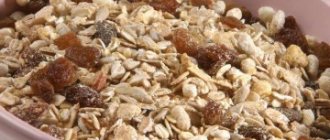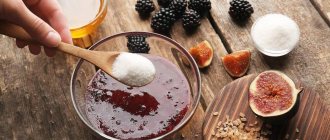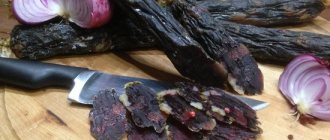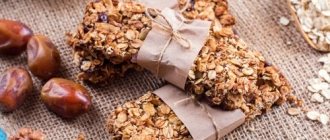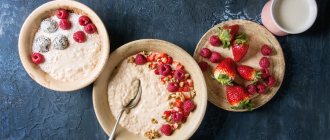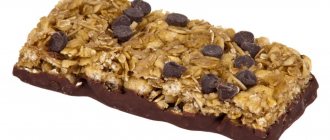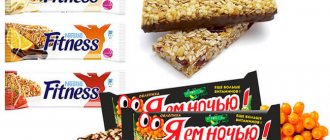Are protein or cereal bars always a really healthy snack? What are the benefits of protein bars? How much added sugar, preservatives, fats and other additives do they contain? Is it true that the labeling on bars often does not coincide with the actual composition, and there are no vitamins and minerals at all? What are the benefits and harms of energy bars? What are the benefits of cereal bars? To answer these and other questions, Roskachestvo experts examined healthy bars of four types from 20 brands: muesli/cereal (7 TM), fruit and fruit-nut bars (6 TM), protein (6 TM) and for weight loss (1 TM).
WHAT BARS ARE HEALTHY AND WHAT CONSUMERS ARE CONCERNED WITH THEM?
The study included four types of bars. They differ in composition and functional purpose. Protein (protein) bars are considered a good source of protein. They are recommended by sports nutritionists and trainers as supplements to the main diet if it is not possible to meet the daily protein requirement with the help of natural products, for example, during periods of weight gain, intense training and competitions. Muesli bars are a source of slow carbohydrates in the form of cereals, and may also contain berries, nuts and chocolate. Weight loss bars help prolong the feeling of fullness and reduce appetite, which is especially important for those who are losing weight. Fruit and fruit-nut bars are rich in fiber and micronutrients and contain beneficial elements from berries, nuts and fruits.
Before launching a special project to study the bars, Roskachestvo analysts studied the opinions of consumers and systematized the concerns associated with these snacks.
Main consumer fears:
- A lot of sugar.
- The calorie content and nutritional supplements declared by the manufacturer do not correspond to the actual values.
- Large amount of saturated fatty acids.
- Unhealthy or no different from regular chocolate bars.
- Unfair labeling.
- The protein content is less than stated.
- Mentioning vitamins and minerals on packaging is a marketing ploy.
- High calorie content (including due to sugar in different types, syrups, etc.).
- Unnatural and harmful composition, presence of trans fats, preservatives.
- Not tasty.
So, many are sure that the bars have an unnatural composition and contain a lot of sugar, preservatives and trans fats. There are concerns with the bars that manufacturers indicate incorrect values on the packaging and that all claims about minerals, vitamins and high protein content are a marketing ploy. Let's check how true this is.
In order to find out which of these fears are groundless and which are justified, Roskachestvo experts examined popular bars: cereal/muesli - Everyday Gigant, DiYes, Healthy Snack, Moy Laik, Corny Big, Musler, Fitness; fruit and nut-fruit – Smart Formula, Pikki, RAW Life, “Frutilad”, Fit&Fruit, Bite; protein - Bombbar, 33 ProteinRex, Champ, Ironman (32 Protein Bar), Everyday, Schwarz; for weight loss – Racionika. Of these, 18 products were produced in Russia, 1 in Poland, 1 in Germany.
The products were studied according to 86 indicators, including labeling, organoleptic properties, amino acid composition and energy value.
Muesli recipes
Muesli contains valuable dietary fiber, vegetable proteins, essential minerals, vitamins and complex carbohydrates. But most often this applies only to homemade muesli bars, the recipe and composition of which includes natural ingredients.
Blueberry Vanilla Yogurt Bars
A great option for breakfast, snack or dessert, it is quite simple and easy to prepare.
Blueberry Vanilla Yogurt Bars
For it you will need:
- 2 tbsp. oatmeal, gluten-free possible;
- 1 tbsp. rice krispies;
- ¼ tbsp. unsweetened grated coconut;
- ¼ tbsp. chopped, roasted almonds;
- 1 tbsp. l. chia seeds;
- ¼ tsp. salt;
- ½ tbsp. peanut or almond butter;
- ½ tbsp. honey;
- 0.5 tsp. vanilla sugar;
- 1 tbsp. dried blueberries.
Ingredients for yogurt coating:
- ¼ tbsp. thick yogurt;
- 1 tbsp. l. water;
- 1 tsp. vanilla extract;
- ½ tsp. gelatin;
- 1 tbsp. l. honey;
- a pinch of salt;
- 50 gr. powdered sugar
In a bowl, thoroughly mix the cereal, coconut, almonds, chia seeds and salt. Separately, you need to mix almond or coconut oil with honey and vanilla sugar. It is best to heat the mixture in the microwave for 30 seconds to 1 minute until it is liquid and hot enough.
The dry workpiece is poured with warm liquid and kneaded well until smooth and moist. Next, blueberries are carefully added, mixed and the finished mixture is placed in an even layer in a container covered with parchment paper.
Using the back of the machine, the mixture is pressed firmly until it becomes compacted into the layer. After which, the muesli goes into the freezer for 1 - 2 hours. Now you can cut the layer into 5 - 8 bars and return it to the freezer. For the glaze, add water to the gelatin and let it swell (you can warm it up a little in the microwave), add vanilla and beat a little.
Separately mix yogurt, honey and a pinch of salt and add gelatin. Next, add powdered sugar and beat until thick. Frozen bars are dipped one side at a time into the prepared yogurt and placed on a baking sheet with parchment paper. As soon as the bars are completely dry, the same manipulations are carried out with the other side of the muesli.
It's best to leave them overnight until the yogurt is dry to the touch. Instead of gelatin, you can use ¼ tsp. agar-agar powder.
Store the finished product in a container in the refrigerator for a week or in the freezer for up to 3 months. Calorie content of the dish per 100 grams. of the product is 340 kcl, proteins - 2.88 g, fats - 12.05 g, carbohydrates - 29.52 g. Instead of blueberries, you can use any berries and dried fruits.
Whole Grain Raspberry Energy Bars
Muesli bars, the recipe of which contains wheat kernels, are rich in B vitamins, minerals, zinc, magnesium and fiber, making it a quality, energy-packed breakfast or snack for those who care about their health.
Whole Grain Raspberry Energy Bars
To prepare muesli you will need:
- 2 tbsp. whole grain flour;
- ½ tbsp. wheat germ;
- ½ tbsp. Sahara;
- ½ tsp. salt;
- 400 gr. butter;
- ½ tbsp. oatmeal;
- ½ tbsp. walnuts;
- ½ tbsp. honey;
- 2 tbsp. l. ground flax;
- ¾ tbsp. raspberry jam or marmalade;
- 1 tbsp. l. lemon juice
In a large bowl, mix flour, wheat germ, sugar and salt. Softened butter is added here and, using a mixer, everything is whipped until smooth. A fifth of the finished mixture should be set aside for later use.
The remaining mass is evenly distributed on the baking sheet and compacted to a height of 1 cm. Before this, the baking sheet must be lined with foil, distributing it so that the edges of the foil hang down, and grease with olive oil. The cake is baked in the oven at a temperature of 190 - 200 ° C for 15 minutes, until its edges turn brown.
The reserved mass is mixed with nuts, flax seeds and 1 tablespoon of sugar (preferably brown).
Place jam, fresh raspberries and lemon juice in a separate container and mix everything carefully. The resulting mixture is laid out and distributed over the hot cake, sprinkled with ready-made crumbs on top and baked for about 20 minutes until golden brown. After the muesli has cooled, it must be cut into squares or bars.
The recipe for this type of food is quite satisfying and nutritious, so it is suitable for active people involved in sports. Since the composition contains sugar, you should not abuse the bars. You can snack on them after a workout or on the go if there are no other options. Nutritional value of the dish per 100 grams. of the product is 384 kcl, proteins - 4.63 g, fats - 26.54 g, carbohydrates - 31.57 g.
Homemade muesli
A delicious combination of healthy multigrain products and juicy pieces of fruit that any sweet tooth will appreciate.
Homemade muesli
Ingredients for the recipe:
- 1 apple;
- 1 pear;
- 1 banana;
- 20 gr. chopped almonds;
- 30 gr. raisins;
- 30 gr. dried apricots;
- 30 gr. prunes;
- 1 tbsp. l. honey;
- 2 tbsp. oatmeal;
- 200 gr. chocolate;
- 100 ml. cream
The fruits are washed, peeled and grated on a fine grater. The banana is mashed with a fork until it becomes puree, the dried fruits are finely chopped. All ingredients are mixed in a container and infused for 10 minutes. The finished mixture is placed on a baking sheet lined with baking paper. The muesli is baked in the oven at 180°C for 20 minutes.
For the glaze, melt the chocolate in a water bath, add cream, and mix well. Hot muesli is coated with a thin layer of chocolate and sliced. The nutritional value of the product will be 247 kcal, proteins 4.4 g, fats 10.4 g, carbohydrates 36.6 g. per 100 grams of product.
Tropical Dreams
For the no-bake muesli recipe you will need:
- 2 bananas;
- 300 gr. oatmeal;
- 300 gr. pitted dates;
- 100 gr. pine nuts;
- 40 gr. coconut flakes;
- 1 tbsp. l. brown sugar;
- 4 tbsp. l. peanut butter.
Tropical Dreams
In a heavy-bottomed frying pan, combine the oats with the brown sugar and caramelize for 5 minutes over low heat. The mixture must be stirred constantly so that it becomes evenly sticky at the end of cooking. Separately, beat dates and bananas in a blender until smooth.
Peanut butter is gradually introduced into the oat mixture, the fruit mixture is added and mixed well. Pine nuts and coconut shavings are poured into the finished muesli and the mass is mixed well again. The baking dish is covered with parchment paper, onto which the mixture is laid out and compacted tightly.
Rectangular cuts are made on the resulting cake with a knife, and the mold is sent to the freezer for 20 minutes, after which the layer can be cut into snacks. The finished product should be stored in an airtight container in the refrigerator. The nutritional value of the product per 100 grams will be 247 kcal, proteins 4.4 g, fats 10.4 g, carbohydrates 36.6 g.
BARS ARE A VALUABLE SOURCE OF PROTEIN OR NOT?
A survey conducted by Roskachestvo showed that when choosing bars, the content of proteins, fats and carbohydrates (BZhU) was a more important criterion than calorie content and price. Experts have found out how much protein the bars contain and how many amino acids can be obtained from them. What is the composition of protein bars?
Amount of protein
Of the 20 TMs, only the Pikki marking did not correspond to the actual value. True, the manufacturer did not overestimate, but underestimated the protein content on the label: tests showed 10.16 g per 100 g instead of the stated 9.2 g.
As expected, protein bars live up to their name: they contain the highest amount of protein compared to other types of bars. But within the group, the spread is more than twofold: the protein snack itself, Schwarz, has 35.7 g per 100 g, while Champ has only 16.9 g.
So what did our review of protein bars reveal? The discrepancy between the declared protein content and the actual protein content in protein bars can be called a myth. The best of them are a good source of concentrated protein and are superior in protein content to many grains, dairy products, meat and fish.
High protein foods (per 100 g):
- Dried porcini mushrooms – 30.3 g
- Peanuts – 26.3 g
- Cheese “Dutch” 45% – 26.3 g
- Tuna – 24.4
- Lentils (grain) – 24 g
- Chicken meat – 18.2 g
- Chicken egg – 12.7 g
“Protein bars are needed by athletes to increase their daily protein intake when making a protein shake or eating a meal is not possible. Carbohydrate and energy bars (containing caffeine or guarana) are used to nourish athletes of cyclic and team sports at a distance or during a game. The good thing about the bars is that you can take them on the go and use them without additional preparation. Plus, you'll get a controlled dose of macronutrients with the bar. Protein bars should be taken evenly throughout the day between meals. You can eat carbohydrates before and during work,” says Honored Bodybuilding Coach of Russia, Master of Sports in Bodybuilding, Master of Sports in Powerlifting Alexey Kornilov.
But you need to remember that even protein bars contain a portion of carbohydrates, the expert clarifies. Those losing weight especially need to monitor their carbohydrate content. It is not recommended to take caffeinated bars in the evening. Do not substitute bars for essential natural meals, but if you have whole food on hand, use it.
“I would recommend using quality bars for people who regularly exercise. In this case, the method of including bars in the diet will depend on the type of sport and on the person’s goals, says nutritionist and member of the Russian Union of Nutritionists, Dieticians and Food Industry Specialists Nagima Semchukova. — Also, sometimes people who are unable to fully eat food (on the road, at a meeting) can get benefits from eating bars. However, remember that you should not regularly replace full meals with bars, no matter how good quality they are.”
Amino acids
Protein not only performs a structural function, but is also an enzyme or biological catalyst that speeds up reactions. Protein molecules consist of amino acids arranged in a certain sequence, and they are divided into two groups: nonessential and essential. The human body can synthesize nonessential amino acids itself, but essential ones must be ingested with food, because their deficiency leads to weakened memory and decreased immunity. There are eight such amino acids: isoleucine, valine, leucine, methionine, threonine, tryptophan, lysine and phenylalanine. The remaining amino acids are classified as non-essential, but some of them are conditional, since a non-essential amino acid can be synthesized in the body only from an essential one.
Thus, it is important to get 11 amino acids from food. According to WHO recommendations, the daily requirement for essential amino acids for an adult weighing 70 kg is 12.88 g. Will one bar be able to cover the need for all of them at once?
One bar is not, but 2-3 bars (depending on the weight of the product) can and will even exceed the norm. Three protein bars will cope with this: Ironman (109% of the daily requirement), Schwarz (109.36%) and Bombbar (123.3%). The Racionika weight loss bar also showed good results – 52.72%.
“If we exercise, we need to count all the calories we consume during the day. A candy bar containing fiber, protein and carbohydrates will be better than a chocolate bar or just some other sweet with sugar and other additives. This bar will take much longer to digest than a regular chocolate bar. But it is worth considering that if the bar contains sweeteners, they can cause discomfort in the intestines. And if the goal is still to lose weight, then, from my point of view, you need to do without bars, but eat whole foods and follow a diet and training regimen,” says Honored Master of Sports, two-time world champion in body fitness, Yulia Ushakova.
Secrets of making muesli
There are many combinations for making mixtures at home, and the number of ingredients can be changed depending on your tastes and preferences.
Some ingredients, such as fresh berries and fruits, are best used immediately before eating muesli. When the mixture is prepared for several weeks, it is worth using dry ingredients, in which case it can stand in a cool place for quite a long time without losing its beneficial properties.
Secrets of making muesli
And in order to get not only a healthy, but also a tasty product, there are several secrets for making muesli:
- Choose regular, old-fashioned rolled oats or other cereals rather than instant cereals;
- raw seeds and nuts must be combined with other ingredients and baked in the usual format; fried nuts and dried fruits should be added after baking, otherwise they may darken;
- vegetable oils give the cereal mixture a crunchy taste, nut oils contribute to the integrity of the consistency, olive oil adds a spicy, bitter taste to the mixture, coconut oil adds a special aroma;
- liquid syrup or honey coats the mixture evenly and prevents the formation of lumps or a grainy structure;
- a small portion of brown sugar added to syrup or honey will add a pleasant caramelized taste;
- As the muesli cools on the baking sheet after baking, it continues to cluster and harden a bit, so it's best to remove it from the oven before it completely darkens.
FATS: SHOULD YOU TRUST THE LABELS?
Among all the bars studied, none of the bars showed discrepancies between the fat labeling and the actual content. However, they found a wide range of indicators in the category of nut and fruit bars. The most saturated with fat found 23.9 g (Pikki), while in the same category the Fit&Fruit bar has only 8.5 g. The presence of nuts in the composition does not mean that the snack will be rich in fat. According to TR CU 022/2011, the daily fat intake should be about 83 g (with a calorie content of 2500 kcal per day). Be mindful of the fat content when consuming nut products.
Tip: Fats can slow down digestion, so nutritionists and athletes do not recommend consuming high-fat bars before physical activity.
When consuming fats, it is important that saturated fats make up less than 10% of your total daily fat intake, and when consuming, you should replace saturated fats and trans fats with unsaturated fats, as recommended by WHO. Not all of the bars studied meet this standard: seven of them contain less than 10% saturated fatty acids (SFA), while for some brands this content exceeds 30%, which is three times the norm.
Benefits of granola bars
However, the average calorie content of muesli bars is about 416 kcal, which is contained in 100 grams of the product. The benefits of muesli bars are due to the composition of the product, which is enriched with a large number of vitamins, as well as other biologically active compounds. As a rule, oat flakes are used to make muesli bars, which are considered an excellent source of carbohydrates that provide energy to the human body.
In addition, muesli bars contain dried fruits, nuts, seeds and honey. All of the above components contain simply a colossal amount of various substances that are certainly useful for humans. Manufacturers recommend using the unique benefits of muesli bars in dietary and sports nutrition.
CARBOHYDRATES: ARE THE FIGURES UNDERGROUND?
Carbohydrates in the product are the main source of calories. Nutritionist Nagima Semchukova explains that all micro- and macronutrients are important and needed by our body, but the effect of nutrients can be different. For example, carbohydrates include both cereal flakes and glucose syrup, but their effects on the body are different. In almost 100% of cases, cereal flakes will benefit you more than glucose syrup. The less processed the constituent ingredients of the bar are, the fewer sweeteners it contains, the healthier it will be for us, regardless of the percentage of ingredients.
During the study, experts checked the declared indicators in the labeling with the actual ones, and also calculated how many calories from the daily requirement can be obtained from one bar. No one wants to go overboard with just one snack.
We took into account the mass fraction of carbohydrates without fiber and found inconsistencies in two TMs:
- “Healthy snack”: the carbohydrate content in the label is 10 times higher. Instead of the declared 78.73 g, only 7.5 g were found.
- Bombbar: the carbohydrate content in the label is underestimated. Instead of the indicated 6.5 g, 17.5 g were found.
According to TR CU 022/2011, it is recommended to consume 365 g or 1460 kcal of carbohydrates per 2500 kcal/day. The largest amount of carbohydrates is found in fruit bars “Frutilad” (73.9 g) and Smart Formula (73 g). For comparison: the Racionika weight loss bar contains 48.7 g of carbohydrates, and the Champ carbohydrate protein bar itself contains 54.6 g. And although Champ has 40.4 g on the label, these are average values, as the manufacturer warns. With regard to indicators of the nutritional value of food products, the labeling may be supplemented with the inscription “average values” (Article 4, Chapter 4.9, Clause 14 of TR CU 022/2011 “Food products regarding their labeling”). In this case, a discrepancy between the declared and actual values is allowed.
To better understand these numbers, let's compare the highest carbohydrate bar with other products:
- Medium banana – 28 g
- Whole wheat spaghetti (140 g) – 37 g
- Plain bagel – 38 g
- Baked sweet potatoes (200 g) – 49 g
Conclusion: one bar will clearly not be enough to immediately exceed your daily carbohydrate intake. Even a banana will be more energy-intensive. Perhaps people with a lot of physical activity, on the contrary, will be disappointed by the relatively low carbohydrate content in one snack. But it should be taken into account that insufficient energy saturation with a bar can lead to the desire to eat another one, and this will already affect the daily calorie intake.
Muesli bar with blueberries and lutein Lose weight in a week
Calorie content: 376 kcal
Proteins, g: 4.2
Fats, g: 12.4
Carbohydrates, g: 60
Ingredients: oat and wheat flakes, extruded cereals (rice, corn), molasses, dark confectionery glaze (sugar, vegetable fat, cocoa powder, emulsifier (lecithin), flavor identical to natural (vanillin)), raisins, dried apples, vegetable oil , blueberry, emulsifier (lecithin), acidity regulator (citric acid), humectant (sorbitol), flavor identical to natural (blueberry), lutein.
My comment: Again the glaze...It always ruins everything. Sugar, vegetable fat...But the calorie content can be called average if you compare all the samples. Lutein is a useful product for our vision, but... It’s in last place in the composition, and it’s clearly not worth buying a bar because of it. And why did the manufacturer mention it in the title? Yellow-red vegetables, persimmons, and eggs contain much more lutein.
DIETRY FIBER: BENEFITS WITHOUT HARM?
Fiber (the second name for dietary fiber) is primarily responsible for the normal functioning of the gastrointestinal tract. Plant fibers come in two types: soluble and insoluble. In the intestines they absorb water and turn into a gel-like substance. According to TR CU 022/2011, it is recommended to consume 30 g of fiber per 2500 kcal per day.
In the course of the study, experts calculated the mass fraction of dietary fiber in a bar per 100 g. As it turned out, the bars are far enough away for one bite to provide the daily amount of fiber. At the same time, the most fiber-rich types of bars were muesli and protein bars, and not fruit and nut bars, as one might expect.
A bar of only one TM can meet the daily requirement - “Healthy snack” (63.44 g per 100 g). No discrepancies were found with any labeling regarding fiber content. As nutritionist Nagima Semchukova warns, eating cereal bars containing a large amount of dietary fiber can lead to intestinal dysfunction.
Benefit
First of all, muesli bars are an extremely simple and quick snack. You can carry the finished bar with you in your purse or in the car, so that if you suddenly feel hungry, you don’t have to look for another snack that could be harmful.
Secondly, they retain a feeling of fullness for a long time, as they take a long time to digest. If a person is on a diet, he can safely replace one meal without physical discomfort. In addition, compressed muesli flakes are an excellent alternative to sweets.
Both when purchasing a finished product and when preparing a bar at home, no large financial outlay is required.
ENERGY VALUE: NOT CORRECT WITH REALITY?
One of the most pressing consumer questions relates to the energy value of bars. Doesn't the manufacturer underestimate the calorie content in the labeling? For those who carefully monitor their weight and count calories, it is important that the snack does not have any hidden calories.
Consumers’ fears were not in vain: almost a third of the brands studied provide incorrect information about the energy value of their products. True, not all of them underestimate calories; there are also those where the number of calories was overestimated.
Nagima Semchukova, nutritionist: If your goal is weight loss, carbohydrate or protein bars, combined with training and a balanced diet, are an excellent tool for achieving your goal. Simply losing weight by eating snack bars is not a good idea. Firstly, it can have the opposite effect because some bars are very high in calories. Secondly, the bars do not contain enough of all the essential nutrients, vitamins and minerals.
DAILY CALORIE NEED: DOES ONE BAR REPLACE A COMPLETE MEAL?
The daily calorie requirement is influenced by several factors: age, gender, body weight, level of physical activity. Accordingly, there are several methods for calculating calorie content for each day. We took the average amount of 2500 kcal per day (according to TR CU 022/2011), but please note that, for example, a 33-year-old woman weighing 55 kg with average physical activity requires a much smaller amount of calories - about 1690 kcal per day.
The highest calorie bar – Pikki – covers almost 1/5 of the daily requirement – 18.4%, while the bar with the lowest calorie content – “Healthy Snack” – only 4.06%. Considering that one “Healthy Snack” bar weighs 55 g, then such a snack will leave too little of a trace in the overall daily requirement - only 2%.
Nagima Semchukova explains: “The bars are a concentrated source of nutrients. However, of course, they should not be used as a regular meal (consumed instead of full meals). Yes, with a high-quality composition, they can serve as a good, healthy addition to a balanced diet, but you should resort to consuming them during periods of high physical activity, as well as in situations where it is not possible to fully eat food (for example, on hikes, trips) or provide compliance with hygiene measures. Bars are a way to provide the body with support in conditions when it is most needed.”
Cereal bars - signs of benefit and harm
If we consider the diametrically opposed opinions and assessments, we can distinguish two main directions. Candy bars can be considered healthy or unhealthy. What does this depend on?
Harmful features of the product
A conversation about the dangers of a product begins with studying its effects on the body. As for bars with a cereal or protein (protein) composition, we can describe situations where they can cause harm. These signs can be applied to any product or dish.
- You replace your main diet with bars, eat them constantly, neglecting breakfast, lunch and dinner, which consists of classic food.
- You don’t focus on the composition, don’t look at what substances are contained in the product in proportion.
- You forget that cereal products and muesli contain very little liquid, which means that they immediately swell and take up a large volume in the digestive tract.
- You proceed only from taste (organoleptic) sensations, without paying attention to their origin - natural, chemical, combined.
Is it possible to eat bars with muesli, cereals and fruits, with added proteins and vitamins, constantly and instead of the main meal? No you can not. This is real harm to digestion.
Useful features of the bars
Now you can consider the benefits of the bars, and they are. The product contains a mass and component ratio of substances and complex components tested by nutritionists. Considering its properties, we can say:
- Taking a bar after and before training, as a light snack between main meals, allows you to close the “windows” of needs for proteins, fats, carbohydrates and fiber without overloading the gastrointestinal tract;
- pieces of fruit and cereals contained in a natural product, upon contact with liquid, become a source of essential substances and vitamins;
- the pleasant taste of natural ingredients lifts your mood, and this helps maintain normal metabolism and improve performance;
- Everyday staple food is not always available in moments of acute hunger - the “carbohydrate window”, and the bar can cover the need without the need to cook or even wash your hands, it is placed in a convenient package.
We have listed the main positive points, including rational considerations, signs of convenience and arguments in favor of using the product wisely.
SUGAR AND GLAZING: LIKE CANDY?
Many consumer concerns were associated with the main property of the bar - its sweet taste. If this snack is so tasty and sweet, then maybe there is nothing in it but sugar?
Glaze
To find out whether the bar was made from the same glaze and wafer wafer, their mass fraction in the entire product was determined. The study did not find figures for half or a third of the bar.
Sugar
When calculating the total sugar content in the bars, the results showed a very wide range of values - from 7.9 g per 100 g to 63.6 (which is almost two-thirds of 100 g of product!). In general, most manufacturers do not provide data on the amount of sugar on packaging, which makes it difficult for consumers leading a healthy lifestyle to make a choice. Only two brands included information about sugar on packaging. But these values did not coincide with the actual ones. The Corny Big label indicates 33 g - in fact 38.1, Fitness - states 22 g, but in fact 37.3.
Manufacturers of 5 brands included the information “no added sugar” on the label, which was confirmed by the study. But sources of sugar in them can be other ingredients from the composition - fruits, berries, dairy products, etc.
According to WHO recommendations, reducing the intake of free sugars to less than 10% of total energy intake is part of a healthy diet, and reducing their intake to less than 5% is believed to provide additional health benefits. You won’t be able to meet the recommended norms with any bar: consuming 100 g of any of them will exceed the norm, but during the day it’s possible to consume other sources of sugar.
Conclusion: in general, fears are justified, since the bars can indeed contain a lot of sugar, and some exceed the daily intake. But among the variety of these products, you can find those in which the sugar content will be less than 10 g (per 100 g), in particular those without added sugar. When choosing, keep in mind that sugar in the bars will still be contained in some of the main components of the product.
Possible harm
Granola bars are often considered a healthy snack, but despite these marketing claims, many are loaded with sugar, calories and artificial ingredients.
For example, Kellogg's Nutri-Grain Harvest bars can contain up to 15 grams of sugar per serving—mostly added sugar. This corresponds to almost 4 teaspoons ().
For reference, health authorities recommend limiting your daily calories from added sugar to a maximum of 10% of your total calorie intake, which equates to 12 teaspoons per day for those eating a 2,000-calorie diet ().
Research shows that excessive sugar consumption may lead to a higher risk of several chronic diseases, including diabetes, obesity and heart disease ().
Although some granola bar manufacturers choose to use sugar alcohols or artificial sweeteners to reduce sugar content, these sweeteners have also been linked to health problems.
For example, sugar alcohols such as xylitol and sorbitol are not completely broken down in your body and can cause digestive problems in people who are sensitive to their effects ().
Other artificial sweeteners such as aspartame, sucralose, and saccharin are FDA approved for use.
However, research suggests that they may interfere with blood sugar control and negatively impact beneficial gut bacteria (, ).
Moreover, many granola bars are highly processed and contain ingredients such as added sugar, vegetable oils, preservatives and artificial flavors.
Research shows that high consumption of processed and sugary foods may increase the risk of metabolic syndrome, which is a group of conditions that can lead to diabetes, stroke and cardiovascular disease ().
Summary:
Granola bars are often highly processed and contain added sugar, artificial sweeteners and sugar alcohols, which can have negative health effects.
VITAMINS INSIDE: MARKETING TRICK OR THE TRUTH?
In various materials on the Internet you can find loud statements that nutrition bars can not only give you a boost of energy, but also become a good source of vitamins and minerals. Consumers whose opinions were asked before the start of the study are skeptical: there are no vitamins in the bars, it’s all advertising. Among the 20 branded bars in our study, only four manufacturers included claims about vitamins and minerals on their packaging. Let's see if we can trust this information.
Minerals
Among all the minerals, two were selected - calcium and iron - to see whether the labeling claims corresponded to the actual content.
Iron. According to TR CU 022/2011, vitamins and minerals constitute at least 15% of the average daily requirement of an adult for vitamins and minerals per 100 g of solid food products. If the manufacturer indicates the amount of some mineral substance on the packaging, then SanPiN allows deviations in this case. According to SanPiN 2.3.2.1078-01 clause 8.3.2, deviations of no more than 20% are allowed for the declared iron content. Among the 20 TMs, only Bite showed a discrepancy: instead of the indicated 2.2 mg of iron, the bar actually contained 2.8 mg.
If we compare the composition of the bars by the presence of iron, the scatter appears to be very large. According to TR CU 022/2011, the recommended daily iron intake is 14 mg. The leader in this indicator, the Fitness cereal bar, covers 81% of the daily requirement, while 33 ProteinRex covers only 6%.
Calcium. There were also no comments regarding the reliability of the calcium content in the labeling. Only one manufacturer inflated the numbers: instead of the stated 300 mg per 100 g, only 103 mg was found. And here the scatter in the content of this element turned out to be quite large. Bars with minimal calcium content will cover 1.5% of the daily requirement of 1000 mg, while the leader, Schwarz, will cover 34% of the daily requirement.
Vitamins
As in the case of minerals, SanPiN allows for a discrepancy between the amount stated in the labeling and the actual content. For different vitamins and vitamin groups there are different deviation standards: for vitamins C, B1, B2, B6 – 20%; for vitamins A, D, E, B12, folic acid – 30%.
In the Roskachestvo study, the presence and content of the following vitamins were determined: B1, B2, B3, B5, B6, B9, B12, C, A, D2, D3 and E. Let us say right away that there are no massive discrepancies between the declared and actual content. Only two brands have inconsistencies:
- Bite: inconsistencies in vitamins B1, B2, B3, B6 and E.
- Schwarz: inconsistencies in vitamins B1, B2, B9, B12, A, D3.
However, you should not rely on the fact that the bar will cover your daily requirement for all essential vitamins and minerals at once. Among all the products studied, there is not a single bar that achieves 100 percent in this regard. There is also no clear leader in terms of the sum of indicators: a certain bar may be a leader in one vitamin group, but will be inferior in terms of the content of other vitamins. Considering this and the wide variation in indicators among TMs, read the labeling carefully. Contrary to expectations, the bars actually contain vitamins and minerals, although their amounts do not always correspond to what is indicated on the label. The differences are small, so in most cases you can count on the fact that you will receive exactly as many vitamins as indicated by the manufacturer.
PRESERVATIVES: USED BUT NOT ALWAYS
To confirm or refute the myth that the bars are unnatural products in which the level of preservatives is off the charts, the level of three acids used in food products as preservatives was determined. Products of all trademarks were tested for compliance with TR CU 029/2012 “Safety requirements for food additives, flavorings and technological aids”, for which the content of benzoic, sorbic and sulfurous acids in them was determined.
FOR REFERENCE
Benzoic acid and its salts are used in food preservation (food additives E210, E211, E212, E213). By blocking enzymes, it slows down the metabolism in many single-celled microorganisms and fungi, inhibits the growth of mold, yeast and some bacteria. It is added to food products in pure form or in the form of sodium, potassium or calcium salts.
Benzoic acid (E210) was found only in products 4, RAW Life, Champ, Ironman (32 Protein Bar). But even in the case of the “My Like” bar with the highest content of benzoic acid (539.6 mg), this cannot be called a violation: the norms of TR CU 029/2012 allow less than 1500 mg of the substance.
However, the natural content of benzoic acid in raw milk can reach 6.0–10.0 mg/kg, in sour cream – 11–18 mg/kg, fermented milk – 12.5–20.0 mg/kg, and with more With a high concentration of raw milk, the content can reach higher quantities. Considering that concentrated whey can be used as protein in bars, the presence of acid in small quantities can be explained by its natural origin.
Sorbic acid was immediately found in 8 TM bars, but again without exceeding the standards of TR CU 029/2012 - no more than 1500 mg. Sulfurous acid was found in 11 TM bars. And again, none of the manufacturers exceeded the standard of 2000 mg/kg of the substance.
As you can see, the myth that the bars consist of solid preservatives is not confirmed. Manufacturers, if they use them, do so without exceeding regulatory standards.
How to choose muesli products
There are two types of muesli:
- Baked (fried), which are mixed with natural juices, honey and baked at low temperatures. This mixture becomes crispier, it is sweeter, but there are also more calories.
- Raw ones are not subject to heat treatment, and they are lower in calories.
Muesli bars, the recipe of which includes oatmeal, dried apricots, raisins, prunes and nuts, are a balanced and healthy composition, prepared at home. A store-bought product is, of course, much more convenient, but if you prepare muesli yourself, you can track and control the calorie content of the dish, add or remove certain products from the composition.
How to choose muesli products
The main thing is that all ingredients are of high quality and fresh. Good quality basic flakes have a creamy-yellowish or white tint, without dark inclusions, impurities or husks. It is best to choose products without flavorings, salt, or flavor enhancers in sealed, opaque packaging.
In paper packages, they easily deteriorate and absorb moisture, and in prepackaged transparent packages, when exposed to light, they quickly lose their beneficial properties. In high-quality products, when opening the packaging, there should be no foreign odors of rancidity or mold; this indicates long-term and improper storage of grains.
The quality of dried fruits is indicated by their appearance. The fruits must be whole, undamaged, dense and elastic, free from foreign impurities, traces of mold, larvae and insects. If dried fruits are wrinkled, it means that the drying technology was not followed and such products will not be tasty.
You should not purchase bright, glossy fruits; this indicates that they have been treated with special additives and preservatives that improve the appearance of the product. Important: along with the familiar dried plums, pears, apricots and cherries, store shelves are increasingly replenished with exotic goods such as dried pineapples, coconut flakes, mangoes, and passion fruit.
All this applies more to candied fruits, when the fruits are soaked, and then boiled in sweet syrup and dried. There is practically no benefit to them, but they may well provoke symptoms of allergic reactions, especially in children. Seeds and nuts of all types can be sold either peeled or in husks.
Unpeeled fruit is stored longer, does not oxidize, does not go rancid, and is not exposed to the environment. It is best to choose seeds in bulk, then you can try them. Good grains should not taste rancid, should not be yellow in color, and should not contain debris.
It is best to store grains in vacuum or metallized containers. As for nuts, preference should be given to fruits in shells, which should be free of mechanical damage and signs of rot. It is better to purchase whole grains rather than ground or crushed grains. The shelf life of such a product is much shorter.
GENERAL RECOMMENDATIONS FOR SELECTION
Carefully study the labeling: manufacturers indicate reliable calorie content and nutritional supplements (with minor deviations). This way you can choose the type of bar taking into account the calorie content of your daily diet. Healthy bars can actually be a source of vitamins and minerals, and in some cases, dietary fiber. But loud marketing promises on the label should not be blindly trusted. This is especially true for sugar: it is contained in all the bars studied, including those without added sugar. With the right choice, a bar can be beneficial - it can be a good source of fiber, protein, slow carbohydrates and microelements.
